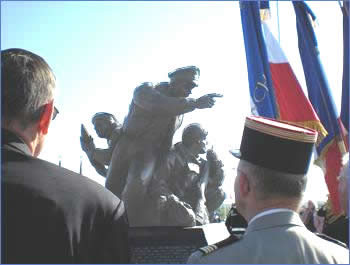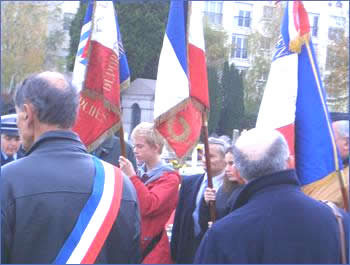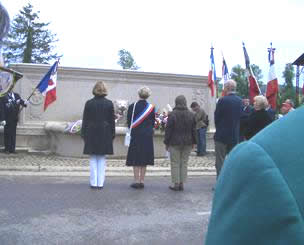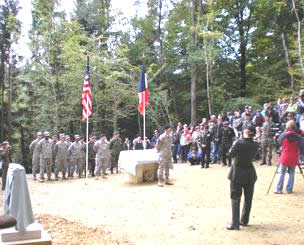
The dedication ceremony for the Navy Memorial at Utah Beach, September 2008
War Memorials are a natural setting for ceremonies remembering the fallen. These ceremonies can take place on holidays (Memorial Day, Veterans Day, 8 May in France), liberation days, or anniversary days of the event commemorated. They can also be organized as dedication ceremonies (when a memorial is first installed) or rededication ceremonies (after a memorial has been renovated, modified, or moved).
Since war memorials are most often planned for, paid for, constructed, and cared for at the local level, war memorial ceremonies strongly reflect the local history, culture, and style. Indeed, the exact form of any war memorial ceremony will generally be a local decision.
Since many people are not entirely familiar with war memorial ceremonies, this page is intended as a guide for their planning. We outline a suggested ceremony order, discuss various components that can be included, and give suggestions on how to get support.
There are no formal rules about how a ceremony should be conducted, and all of the ideas below should be adapted to local circumstances.
Ceremony Order
Welcome. Introduction to the ceremony by the master of ceremonies. Why are we here? What are we commemorating? Who is participating? The master of ceremonies guides the public through the ceremony, introduces the speakers, and instructs people when to stand, sit, have a moment of silence, etc.
Posting of the Colors. If a military color guard is available, colors are posted first. All rise as the colors are posted.
Invocation. Given by a chaplain, priest, minister, or rabbi. All rise.
The National Anthems. If music is available the national anthems of the host nation and the US should be played. All rise.
Remarks. Speeches by the dignitaries present. Be careful to invite speakers from the host nation as well as from the United States. Be prudent: do not have too many speakers. Remember that translating speeches from the host nation language to English and vice versa doubles the length of the discourse.
Presentation of the memorial. For memorial dedication or rededication ceremonies, the memorial is usually covered until this point in the ceremony and is then unveiled by some of the dignitaries, veterans, or family members present.
Moment of Silence. A moment of silence is often observed during war memorial ceremonies. This can be ended with the playing of taps if music is available.
Wreath Laying. Flower wreaths are laid by representatives of organizations involved. This often includes the town, the region, veterans associations, the family, and any sponsoring organizations. The wreaths are purchased by the organization laying them.
The Benediction. A closing prayer, often delivered by a chaplain, priest, minister or rabbi.
Posting of the Colors. If a color guard is present, the colors exit at the end, while all rise.
Reception. It is customary to hold an informal reception at the conclusion of the ceremony close to the ceremony location.

Host nation flag bearers are a welcome addition to
war memorial ceremonies overseas.

Rededication ceremony for
the Roosevelt Fountain in Chamery, France, June 2006.

Dedication ceremony for the SGT York Medal of Honor Site by Chatel-Chehery, France in October 2008.
Resources
For American troop support for war memorial ceremonies, you must pass a request through the Defense Attaché Office of the American Embassy in the country involved. American troop support can be an active duty officer or NCO representing the Embassy, a color guard (4-6 soldiers with flags), an honor platoon (10-20 soldiers who march into the ceremony and participate in uniform), a bugler, a band, or even a flyover (an aircraft or multiple aircraft who fly over the site at a specific time).
Please keep in mind that there are thousands of American War Memorials overseas and that our embassies receive hundreds of requests for ceremony support every year. Unless your memorial is extremely visible and well known, or your occasion absolutely compelling, it is rare to receive US troop support.
The American Legion and the Veterans of Foreign Wars (VFW) have posts all over the world. These posts are often very involved in supporting local ceremonies. They can help with the conduct of your ceremony, and can be a valuable resource. This is a viable alternative to troop support.
Foreign troop support is another possibility. It is usually requested through host nation channels. If your memorial is in close proximity to a foreign troop installation, or if your memorial's history has close ties to a foreign unit, foreign troop support can sometimes be easier to secure than US troop support.
Host nation veterans organizations or reenactment organizations exist wherever Americans fought. These can be a valuable resource for you in planning and executing ceremonies. These groups exist to keep alive wartime memories, and can add color, culture, and authenticity to war memorial ceremonies. Veterans organizations will come with their impressive flags, and reenactment organizations will come in period uniforms. Both have tremendous ceremonial experience.
Considerations
Weather. War memorials are almost always outside, so weather is always a consideration. While there is little you can do to weather proof your ceremony, the reception afterwards should always be held in a covered location. Ceremony participants should be reminded to dress for the weather and bring rain gear.
Translations. Overseas war memorial ceremonies should be conducted in both the host language and English whenever possible. There is no requirement to translate every phrase uttered during a ceremony, but an honest effort to include as least some aspects in each language is absolutely appropriate. A bilingual master of ceremonies goes a long way to insure that all participants feel welcome and understand the main themes of the event. Indeed, attempting to translate every aspect of the ceremony adds lots of complication and doubles the length of the ceremony, so is often not appropriate.
Veterans. The National Defense Authorization Act of 2008, signed into legislation on 28 January 2008, allows veterans and members of the Armed Forces not in uniform to salute the American flag when it is raised, lowered, or passes. Previously, they rendered honors by placing their right hand over their heart. They now have a choice as to how to honor the flag. Follow-up legislation passed on 14 October 2008 allows veterans and servicemembers not in uniform to render the military-style hand salute during the playing of the national anthem as well.
Military retirees are authorized to wear their uniforms and insignia after separation from the service. They can wear the current uniform, or the last one worn on active duty, to patriotic functions such as war memorial ceremonies. They can wear any medal, campaign ribbon or decoration they were authorized to wear while on active duty or in reserve status.
